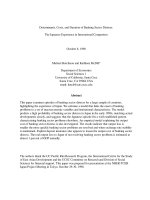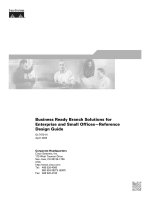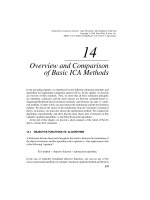Tài liệu Michael Hutchison & Kathleen Mcdill - Determinants, Costs, And Duration Of Bank Sector DistressPdf doc
Bạn đang xem bản rút gọn của tài liệu. Xem và tải ngay bản đầy đủ của tài liệu tại đây (76.56 KB, 29 trang )
Determinants, Costs, and Duration of Banking Sector Distress:
The Japanese Experience in International Comparison
October 8, 1998
Michael Hutchison and Kathleen McDill*
Department of Economics
Social Sciences 1
University of California, Santa Cruz
Santa Cruz, CA 95064 USA
email:
Abstract
This paper examines episodes of banking sector distress for a large sample of countries,
highlighting the experience of Japan. We estimate a model that links the onset of banking
problems to a set of macroeconomic variables and institutional characteristics. The model
predicts a high probability of banking sector distress in Japan in the early 1990s, matching actual
developments closely, and suggests that the Japanese episode fits a well-established pattern
characterizing banking sector problems elsewhere. An empirical model explaining the output
cost of banking sector distress is also investigated. The results indicate that output loss is
smaller the more quickly banking sector problems are resolved and when exchange rate stability
is maintained. Explicit deposit insurance also appears to lessen the output cost of banking sector
distress. The real output loss to Japan of not resolving banking sector problems is estimated at
almost 1 percent of GDP annually.
The authors thank the UC Pacific Rim Research Program, the International Centre for the Study
of East Asian Development and the UCSC Committee on Research and Division of Social
Sciences for financial support. This paper was prepared for presentation at the NBER-TCER
Japan Project Meeting in Tokyo, October 29-30, 1998.
2
1. Introduction
Recent events in Japan and East Asia draw renewed attention to the many problems
associated with financial sector distress— how quickly and unexpectedly crisis situations arise,
disruption in credit channels, economic contraction, and the difficulty in designing effective
policy responses. Japan’s banking problem emerged gradually in the early 1990s and has since
attracted increasing attention, evidenced most recently (October 1998) when representatives of
the Bank of Japan had a public row with the Ministry of Finance over measures of bank capital
and the extent of the non-performing loan problem.
The general features of banking sector distress in Japan are by now well recognized (e.g.
Cargill, Hutchison and Ito, 1997, 1998; Hutchison, 1997; OECD, 1998). In important ways the
Japanese case resembles episodes of banking sector distress seen in many countries-- booming
economies and sharply rising asset prices, followed by recession, severe asset price decline and
the emergence of banking problems. The international character of the asset price boom, and
subsequent collapse, suggests common explanatory factors.
This paper investigates the causes and consequences of banking sector distress in a large
sample of countries, highlighting the special circumstances of the Japanese case. We review
some of the basic statistical characteristics of countries experiencing banking sector distress and
test several empirical propositions about the factors that affect the probability of having banking
problems. In particular, we estimate a model that links the onset of 65 episodes of banking
sector distress to a set of macroeconomic variables and institutional characteristics. We employ
this model to predict the likelihood of banking sector distress emerging in Japan, and investigate
whether this episode fits an internationally recognized pattern.
We also seek to identify factors that influence the way economies respond to banking
sector distress. We focus on the “output cost” associated with episodes of banking sector
distress, i.e. the (present discounted value) loss in output that may be attributed to banking
problems. Beyond controlling for the state of the business cycle, potential determinants of the
output cost that we consider include institutional features, such as the existence of deposit
insurance, and policy measures such as the speed at which the banking problem resolved.
3
Our major finding is that Japan’s banking crisis follows a pattern found in many other
countries, and formal tests do not distinguish Japan as a special case. Our model predicts that
Japan was particularly “vulnerable” to banking sector distress in the early 1990s. That is, the
model indicated that there was almost a 20 percent probability of banking sector distress in
Japan in 1992 given the configuration of asset prices, credit conditions and other economic
factors prevailing at the time. The results also indicate that output loss associated with an
episode of banking sector distress is smaller the more quickly banking sector problems are
resolved and when exchange rate stability is maintained. Explicit deposit insurance also appears
to lessen the output cost of banking sector distress. The real output loss to Japan of not
resolving banking sector problems is estimated at almost 1 percent of GDP annually. The main
factor distinguishing Japan from other countries is the slow and poorly designed policy response
by the Japanese government to resolve the country’s financial crisis.
In the next section, Section 2, we briefly review the theoretical and empirical literature on
financial and banking sector distress. In section 3 we discuss the data for the study. In section 4
we present summary statistics, comparing the economic and institutional characteristics
distinguishing those countries that have experienced episodes of banking sector distress and the
characteristics of economies in the lead-up to and aftermath of episodes of banking sector
distress. This section also presents estimates of the probit model, and considers the predictions
of the model for Japan. Section 5 presents the estimates of the model linking the output cost of
banking problems to observable characteristics prior to the onset of the crisis and policy actions
taken following the crisis. Section 6 concludes the paper.
2. Analytical issues and empirical literature
Much of the theory on banking crises focuses on the special characteristics of banks, such
as maturity and currency transformation and asymmetric information, which make the industry
particularly vulnerable to collapse following adverse shocks (e.g. Jacklin and Bhattacharya,
1988 and Diamond and Dybvig, 1986). Institutional features of economies, such as the
existence of deposit insurance and market-determined interest rate structure, are also
emphasized in the literature as impacting the profitability of banks and the incentives of bank
4
managers to take on risk in lending operations. The special features of banks, combined with
particular institutional characteristics of economies, frequently lead to the emergence of banking
problems when adverse macroeconomic shocks such as a fall in asset prices (impacting bank
capital and/or collateral underlying loans) or economic activity (more delinquent loans) occurs.
Empirical regularities
Several common features of countries experiencing banking problems emerge from
numerous case studies. A recent IMF (1998) report summarizes this literature and identifies
several general categories of problems frequently associated with financial crises: unsustainable
macroeconomic policies, weaknesses in financial structure, global financial conditions, exchange
rate misalignments, and political instability. Macroeconomic instability, particularly
expansionary monetary and fiscal policies spurring lending booms and asset price bubbles, has
been a factor in many episodes of banking sector distress, including most experienced by the
industrial countries in the postwar period. External conditions, such as large shifts in the terms
of trade and world interest rates, have played a large role in financial crises in emerging-market
economies. By affecting the profitability of domestic firms, sudden external changes can
adversely impact banks’ balance sheets.
Weakness in financial structure refers to a variety of circumstances ranging from the
maturity structure and currency composition of international portfolio investment flows to the
allocation and pricing of domestic credit through banking institutions. These weaknesses
oftentimes arise in times of rapid financial liberalization and greater market competition, when
banks are taking on new and unfamiliar risks on both the asset and liability side of balance
sheets. Weak supervisory and regulatory policies under these circumstances have also increased
moral hazard by giving an incentive for financial institutions with low capital ratios to increase
their risk positions in newly competitive environments, and allowing them to avoid full
responsibility for mistakes in monitoring and evaluating risk. Further, deficiencies in accounting,
disclosure, and legal frameworks contribute to the problem because they allow financial
institutions (or financial regulators) to disguise the extent of their difficulties. Governments have
5
frequently failed to quickly identify problem institutions, or to take prompt correct action when
a problem arises, resulting in larger and more difficult crisis situation.
Formal Studies on the Probability of Banking Sector Distress
Several recent econometric studies, moving beyond individual case studies and
descriptive international comparisons, have tested the statistical significance of a number of
variables in predicting banking sector distress. In terms of institutional characteristics, Kaminsky
and Reinhart (1996), estimating a probit model, find that financial liberalization increases the
probability of a banking crisis. DemirghH-Kunt and Detragiache (1998a) also use probit analysis
and find that financial liberalization is an important determinant of banking crises. In a related
study, DemirghH-Kunt and Detragiache (1998b) find that explicit deposit insurance (increasing
moral hazard) and low values of a “law and order” index (a proxy for a weaker regulatory and
supervisory structure) also appear to be important institutional characteristics increasing the
likelihood of a banking problem.
In terms of macroeconomic disturbances, DemirghH-Kunt and Detragiache (1998b) find
that low real GDP growth is contemporaneously associated with banking crises but is not a
useful leading indicator. They also find that (i) high real interest rates, (ii) high inflation, and (iii)
external vulnerability (measured by a high ratio of broad money to international reserves) help
predict the onset of a banking problem. Calvo (1996) argues that the M2/Reserves ratio is a
good predictor of a country’s vulnerability to balance-of-payments crises. Eichengreen and Rose
(1998), focusing on developing economies, find that increases in world interest rates,
overvalued real exchange rates and slowing domestic output growth increase the probability of
a banking problem. However, neither DemirghH-Kunt and Detragiache (1998b) nor
Eichengreen and Rose (1998) find that rapid credit growth help predict exchange rate crises.
Other variables commonly found in empirical work include the government budget surplus, e.g.
governments in a strong financial position may be likely to quickly re-capitalize problem banks,
and the terms-of-trade.
Output Cost of Banking Crises
6
The theory explaining the wide variation in economic outcomes following the emergence
of banking sector distress is much less well developed than that explaining why crises may arise.
Nor is there a consensus over the appropriate design of policy when confronted with a banking
problem. The literature guides empirical work to some extent, however, in that several
institutional characteristics and macroeconomic policy variables have been suggested as
potentially important factors influencing how economies develop after the emergence of banking
sector distress.
Three characteristics of economies, evident prior to the development of banking sector
problems, are noted as influencing the way economies respond: the state of the business cycle
(“prior state of the economy”), the rate of inflation (“prior inflation”), and whether a system of
explicit deposit insurance was in place (“explicit deposit insurance”). Controlling for the state of
the business cycle prior to the onset of banking problems is obviously important, as output
developments around trend are highly path dependent. The rate of inflation prior to the onset of
a banking problem may also influence the ultimate output cost. Financial sectors in countries
with relatively high inflation over a sustained period (defined here as average inflation over a
five-year period prior to the onset of banking sector problems) may already have adjusted to
financial sector dislocation, investing the resources to make them less vulnerable to a banking
sector problem. This is related to the “New Keynesian” view of how economies and financial
sectors adjust to the historical experience of sustained inflation (Ball, Mankiw and Romer,
1988)
1
.
Deposit insurance, combined with financial liberalization, creates conditions (moral
hazard) under which banking problems are more likely to occur. However, given that banking
sector distress is already evident, an economy with explicit deposit insurance may be able to
maintain greater confidence in the banking sector and limit contagion (e.g. depositor panic and
1
We also add an intercept dummy variable for very high inflation countries (“high inflation slope dummy”).
This is defined as countries with 30 percent average annual inflation or greater in the five-year period preceding
banking sector distress. Empirical evidence suggests that the response of real variables to inflation is often quite
different in those economies where high inflation is the norm.
7
bank runs). Most severe banking problems in recent decades were associated with deterioration
in asset quality, not with contagion associated with bank runs. Deposit insurance may play a
role in maintaining confidence in the banking system. Maintaining confidence, in turn, would
presumably be associated with continuation of banking relationships and credit flows, and less
output loss when a banking problem arises.
Three factors which are related to the policy response taken after banking sector distress
are also frequently discussed in the literature: duration of the banking problem (“duration”), the
change in policy interest rates and the rate of exchange rate depreciation. There is no single
quantitative measure of the speed, effectiveness and extent of policy actions taken to contain
and resolve banking sector distress. However, the duration of banking sector distress, measured
simply in years during which severe banking problems are observed, serves as a rough indication
of the adequacy or effectiveness of the policy response. Numerous episodes demonstrate that
effective regulatory policy can contain and resolve even severe banking problems quite quickly.
But there are other cases that demonstrate how effective policies may be stymied by institutional
or political factors. Regulatory authorities, for example, may follow a “forbearance” policy
(inaction) or the political process may not be able to reach a consensus over the appropriate
design and source of funds to re-capitalize financial institutions facing severe problems. The
duration of Sweden’s banking sector distress, for example, was four years and that of Japan is
seven years (1992-98) to date. This suggests a sharp contrast in the speed and effectiveness by
which the two countries responded to their respective banking problems.
The optimal policy response when confronted with banking problems is controversial. A
significant decline in policy interest rates (money market rate or discount rate) at the onset of
banking sector distress help offset the adverse effects on aggregate demand arising from
banking sector distress
2
. Declining interest rates, however, may exacerbate banking distress by
encouraging foreign capital outflows, weakening the exchange rate and generally lowering
investor confidence that prudent macroeconomic policies are being followed. These two
channels are likely to have offsetting effects on GDP, and the net impact is ambiguous.
2
The empirical results are not qualitatively different if short-term real interest rates are used in the regressions
rather than nominal rates.
8
The role of exchange rates in the stability of the banking sector is also debatable and is
only partially under the control of policymakers. Although exchange rate depreciation may be
expected to exert a positive demand stimulus, it also incurs losses to a financial sector holding
net foreign liabilities denominated in foreign currency. If the latter effect dominates, currency
depreciation may worsen the banking problems and lead to a larger output loss. This effect has
recently been observed in Korea, Indonesia and elsewhere in East Asia where domestic financial
institutions held large net (short-term) foreign liabilities denominated in foreign currency.
3. Data
We follow previous studies in guiding our selection of a number of the explanatory
variables. However, several variables, such as the definition of banking sector distress and
measurement of the output cost of the banking crisis, require explanation.
Defining Banking Distress
Banking problems are usually difficult to identify empirically because of data limitations.
The potential for a bank run is not directly observable and, once either a bank run or large-scale
government intervention has occurred, the situation most likely will have been preceded by a
protracted deterioration in the quality of assets held by banks. Identifying banking sector
distress by the deterioration of bank asset quality is also difficult since direct market indicators
of asset value are usually lacking. This is an important limitation since most banking problems in
recent years are not associated with bank runs (liability side of the balance sheet) but with
deterioration in asset quality and subsequent government intervention. Moreover, it is often
laxity in government analysis of banking fragility, and slow follow-up action once a problem is
recognized, that allows the situation to deteriorate to the point of a major bank crisis involved
large-scale government intervention.
Given these conceptual and data limitations, most studies have employed a combination
of events to identify and date the occurrence of a bank crisis. Institutional events usually include
forced closure, merger, or government intervention in the operations of financial institutions,
runs on banks, or the extension of large-scale government assistance. Other indicators
9
frequently include measures of non-performing assets, problem loans, and so on. We have
identified and dated episodes of banking sector distress following the criteria of Caprio and
Klingebiel (1997) and DemirghH-Kunt and Detragiache (1998). If an episode of banking
distress is identified in either study, it is included in our sample. If there is ambiguity over the
timing of the episode, we use the dating scheme of DemirghH-Kunt and Detragiache (1998)
since it tends to be more specific about the precise start and end of each episode
3
. We have
updated these samples using data from the Bank for International Settlements (1998).
Although the dating of banking sector distress is somewhat arbitrary, we nonetheless
follow these studies closely to avoid “data mining”, i.e. identifying the date of the banking crisis
after observing developments in macroeconomic and other variables thought to be determinants
of the crises. Japan’s banking crisis, for example, is dated by Caprio and Klingebiel (1997) as
“the 1990s” and by the DemirghH-Kunt and Detragiache criteria as starting in 1992. 1992 was
the first year of substantial government attention to the problem. However, the first substantial
plans for restructuring a significant part of the financial sector wasn’t until 1993 and many
observers wouldn’t characterize the Japanese banking problem as a full-blown “crisis” until
1995. On the other hand, using realistic estimates of non-performing loans as an indicator might
date the beginning of Japan’s banking distress already in 1991.
We initially consider data for 132 countries over the 1975-97 period, of which 67 had one
or multiple episodes of banking distress. We identify 82 episodes of banking distress of different
magnitudes. The minimum data requirements to be considered in this study is that GDP and
inflation are available, which in turn limits the sample to 98 countries. Of this group, 44
countries had no episodes of banking distress and 53 countries (65 episodes) had severe banking
problems at some time during the sample.
3
DemirghH-Kunt and Detragiache (1998) identify banking sector distress as a situation where one of the
following conditions hold: ratio of non-performing assets to total assets is greater than 2 percent of GDP; cost of
the rescue operation was at least 2 percent of GDP; banking sector problems resulted in a large scale
nationalization of banks; and extensive bank runs took place or emergency measures such as deposit freezes,
prolonged bank holidays, or generalized deposit guarantees were enacted by the government in response to the
crisis.
10
Institutional Variables
Our source on the existence of explicit deposit insurance is the recent survey on the issue
by Kyei (1995). We construct a dummy variable that takes a value of unity at times when a
particular country had a formal system of deposit guarantee arrangements in place, and zero
otherwise. In the Kyei study, forty-seven explicit arrangments were identified, as against fifty-
five arrangments implicitly guaranteeing government support for deposits. Our main source for
the financial liberalization data is DemirghH-Kunt and Detragiache (1998a), supplemented by
national and international sources. The variable is constructed on the basis of the beginning of
observed policy changes to liberalize interest rates, taking on a value of unity during the
liberalized period of market-determined rates and zero otherwise. Our central bank
independence variable is taken from Cukierman (1992). It takes on a value from zero (no
independence) to unity (complete independence), and represents a weighted average of legal
and institutional characteristics reflecting the central bank’s relationship with the government.
Macroeconomic Variables
The macroeconomic variables employed are standard in this literature: real GDP growth,
the rate of exchange rate depreciation, real credit growth, nominal (and real) interest rate
increase, inflation (and a dummy variable taking on a value of unity for countries with sample
average inflation rates over 30 percent, zero otherwise), the change in an index of stock prices,
and the budget position of the general government. We also consider the M2/Reserve ratio
(ratio of a broad money aggregate to international reserves) as an indicator of the extent to
which the country is vulnerable to balances-of-payments crises.
Output cost of banking sector distress
We measure the output cost associated with each episode of banking sector distress as
the present discounted value (at a 3 percent discount rate) of the cumulative output loss starting
from the year after which banking sector distress is identified. The Hodrick-Prescott filter is
used to estimate the “normal” or trend output level, and the output gap is measured as the
percentage difference of actual from trend output. When the output gap is negative following a
11
banking problem (49 episodes), the (discounted) sum of the output gap loss is calculated up to
the point to where the output returns to within 0.5 percent of trend. When the output gap is
positive following the onset of a banking problem (12 episodes), no recession had occurred, and
the single year’s (positive) output gap is considered an output gain.
4
Section 4. Predicting Banking Crises
This section presents a model linking economic developments and institutional structures
to banking crises. We investigate whether economic and institutional characteristics of countries
are associated with the onset of banking crises, and use the model to see if Japan's banking
problems fit a pattern seen in other countries. Our objectives are both to investigate the general
characteristics associated with episodes of banking sector distress, and to determine whether
Japan's experience (or circumstances surrounding the banking crisis) is idiosyncratic. Using a
panel data encompassing 97 countries (65 episodes of banking distress) over the 1975-97
period, we use a multivariate probit analysis to estimate how a particular variable changes the
probability of the occurrence of banking sector distress holding constant the other explanatory
factors.
Summary Statistics
Table 1 shows the differences in economic characteristics between the group of
countries experiencing banking distress and the group that avoided severe problems. The
average values of these variables are calculated over the full sample period for those countries
which have not experienced banking sector distress and over the period leading up to the
banking crisis for the other countries. The objective is to identify different movements in these
variables that distinguish the crisis and non-crisis countries during the periods of relative
tranquillity, i.e. before banking problems become critical.
4
An alternative would be to drop from the sample those episodes in which an output did not
decline below trend following the onset of banking distress. This would lose potentially
revealing information, however, about those factors which contributing to such a favorable
outcome.









